The grand finale of our 5 day Salkantay hike was a tour of Machu Picchu. We had seen the ruins from a distance the day prior, but today was the big day that I have been looking forward to for a long time.
It was an early start in order to catch the sunrise from the ruins. Since we had put in over 60km in the last 4 days, our tour group decided to take the bus from Aguas Calientes to the entrance instead of hiking the 1.5 hours uphill. It was a good decision since the hike was on stone staircases and the main road, plus we would not have seen anything in the dark. The only bad thing was that Mike had to throw out his hot coffee that he hadn’t even taken a sip of yet to board the bus. He was a little grumpy after that but cheered up as soon as we started the ride up the hill!
The gates opened at 6 AM, and most of the tourists headed uphill to the funeral hut for the classic sunrise views of Machu Picchu and to watch the sunrise. However, our guide, the notorious Freddie, took us to the lower terraces. We still got a great view, but it wasn’t a good start to our 3 hour guided tour.
The natural setting has the sun rising perfectly over the sun gate, where the Inca road enters Machu Picchu on the summer solstice and in a niche in the green mountains for the winter solstice. Since we were only 1 week off from winter solstice, the sun rose fairly close to the niche, which was cool! The famous sun temple has two windows, and each is lined up perfectly to receive the sun beams of summer and winter solstice.
Machu Picchu is thought to have been a university for agriculture, religion, and astrology. It was rediscovered in 1911 by an American, Hiram Bingham. He did not find any gold but many pieces of pottery and other artifacts. Much of the city still remains a mystery.
I will share a few of my favorite sites as there was so much to see throughout the ruins. I was amazed at the stonework and engineering of the city on top a mountain. The natural beauty of the surrounding green mountains really added to the overall picture of the ruins. We had a beautiful sunny day, so we did not capture that misty, mysterious look of the city.
The sacred water fountains are amazing and run through the center of the ruins. They still work today, although with less water pressure as some of the water is now used for the nearby hotel. The fountains cascade onto each other and channel all the way down the mountainside. The top fountains were sacred for use by the priests and nobles only, and the common people used the lower fountains.
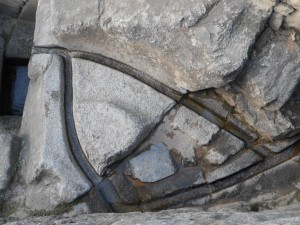
The Sacred Plaza is above the main city and is in a ‘U’ shape with the High Priest House, Temple of the Three Windows, and the Main Temple. The open side has views of the snow-capped mountains and green valleys. From here, we could see where we were the prior day.
In the plaza were 3 carved rocks. One was shaped like a diamond with tiny altars around it. It is thought that it is in the shape of the Southern Cross with each point in the cardinal directions. It is in the exact position of the Southern Cross in the sky at harvest time. The other two rocks are altars too, but not much is known about them.
The Temple of the Three Windows looks over Machu Picchu with 3 perfectly spaced trapezoidal windows. What amazing stonework to make them the same size and at the same exact height as well! The Incas used trapezoidal windows and doors in all their building because they added stability during earthquakes. On the plaza side of the temple was half of a carved Incan cross symbolizing the rules of their society. Our guide skipped this and said it was not significant, so we learned about it from our friend, Marcos! That Freddie!
On the final side was the main temple. On the far side were 7 identical trapezoidal niches at the exact same height above a huge single rock that was the altar. On the sides closest to us were huge rocks that made up the walls. I kept thinking to myself, “how on earth did they move these huge boulders”?! This was also the location where we could easily see how much Machu Picchu is sinking, as they have braces up to help support the building walls.
The most famous part of Machu Picchu is Intiwatana (Hitching Post of the Sun). This rock sits on one of the highest sections of the ruins. The rock was carved with a pillar on top, which is a dial to tell the seasons. The pillar’s shadows hit a small circular carvings on nearby rocks for the solstices. The base of the rock is rectangular with one corner pointing to magnetic north. It is amazing to see what the Incan’s knew and built in their time!
The Temple of the Condor was used for sacrifices of llamas. On the ground, the beak and head of the condor was carved into a large stone. This is where the llama was killed, and the blood pooled in the niche of the condor’s beak. Above this carving were natural boulders, too, that formed the condor’s wings.
Our less than desirable guided tour by Freddie left out the Sun Temple and Royal Tombs which are two main highlights! Luckily, we had some spare time to explore them on our own and listen in to other tour guides to find out their significance! The Sun Temple was spectacular as is it in a rounded shape so the stonework is really amazing!
Underneath the Sun Temple are the Royal Tombs, even though no bodies were ever found here. There were several niches in the walls for the mummies. The rock was carved on each side to form holes to create a sort of seat belt to keep the mummies in their place. There was also an Incan cross and some more great examples of their stonework!
Huayna Picchu means “new mountain” and provides the famous backdrop of the ruins. The hike to the top is a steep staircase, and my tired legs protested, but we eventually were richly rewarded with amazing views of the ruins. The city was built in the shape of a condor. This symbolized the spirit and conveyance to the after life. It took us all awhile to see the image as it was upside down from our viewpoint. There were also great views of the surrounding valley and mountains. I can sure see why the Incas chose this location for their sacred university!
Our final site of the day was the funeral rock and the postcard view of Machu Picchu. The funeral rock is a huge boulder carved and used for offerings. We took lots of photos and soaked up the energy and mystery of this spectacular city from this great vantage point. I really could have spent a couple more hours to wander around and explore all of the small details.
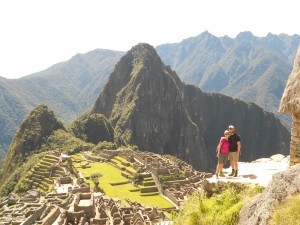
The day ended with a train and bus ride to Cusco to say goodbye to our new friends. It had been an amazing adventure and Machu Picchu exceeded our high expectations. It truly was spectacular and a major highlight in our year of touring!
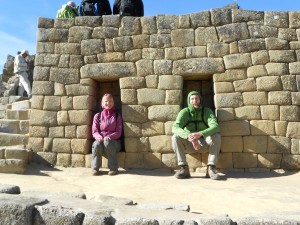

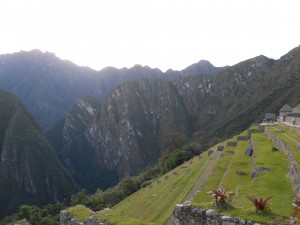

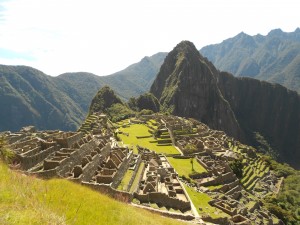
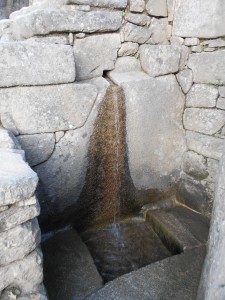
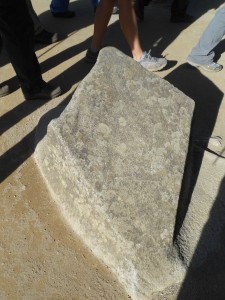
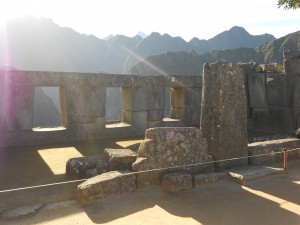
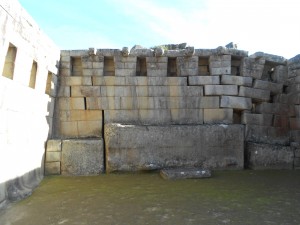

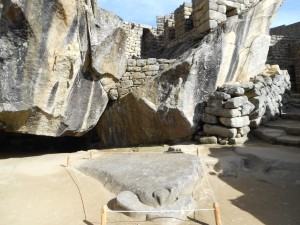
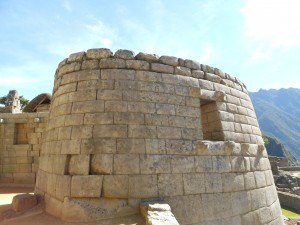
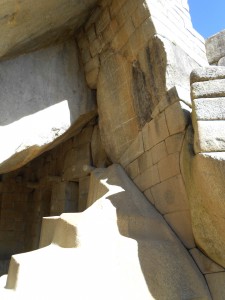
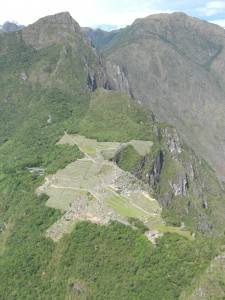
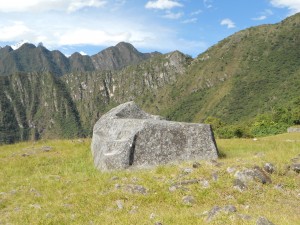
Wow. Your pictures are so much better than the ones in a book I just read, *Turn right at Machu Picchu*. Absolutely fascinating. Good for you guys for actually going there. Awesome!
Thanks Joan! I am so glad you enjoyed looking at our pictures. Machu Picchu is sure an amazing place!